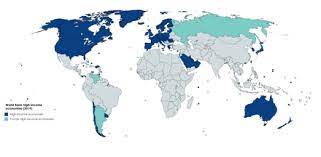
Global South: Origin and Significance
Global South: Origin and Significance
Main Examination: General Studies Paper 2
(Agreements affecting the interests of India)
12 JULY, 2023
In News:
- At present the Global South has become politically and economically capable to a great extent, which is far ahead of the 'developing countries' and 'third world' countries.
About Global South:
- The Global South refers to various countries around the world that are sometimes described as 'developing', 'less developed' or 'underdeveloped'.
- The Global South includes countries in Asia, Africa, South America and Latin America.
- Global North refers to countries like America, Canada, Europe, Russia, Australia and New Zealand.
- In general, they are poorer than countries in the "Global North", have higher levels of income inequality and face lower life expectancies and difficult living conditions
- Some countries of the Global South are also located in North America, Europe and Oceania.
Origin of the term Global South
War in Vietnam:
- The term Global South appears to have been first used by political activist Carl Ogles in 1969 when he argued that the war in Vietnam was the culmination of a history of Northern "domination of the Global South".
Dissolution of the Soviet Union:
- It was only after the collapse of the Soviet Union in 1991 – which marked the end of the so-called "Second World" – that the term gained momentum.
- Until that time, the more general term for developing countries—countries that were not yet fully industrialized—was the 'Third World'.
End of the 'Third World':
- The collapse of the Soviet Union and the end of the so-called Second World also provided a convenient excuse for the disappearance of the term 'Third World'.
- Meanwhile 'developed', 'developing' and 'underdeveloped' people also faced criticism for idealizing Western countries and portraying people outside that club as backward.
- The more neutral-sounding term "Global South" was being used in their place.
Importance of Classification
Not Geographical Concept:
- The term 'Global South' is not geographical. In fact, the two largest countries in the Global South – China and India – are located entirely in the Northern Hemisphere.
- Rather, it is used to denote a mixture of political, geopolitical and economic similarities between nations.
Shared Similarities:
- What differentiates the Global North and South is that, first, they are arguably more accurate in grouping countries together, measuring the same in terms of wealth, education and health care indicators, etc.
- Another commonality among the countries of the South is that most countries have a history of colonization, mainly at the hands of European powers.
Challenging the norm:
- The progress achieved by many Asian countries is also seen as challenging the idea that the North is the norm.
- Many believe that the world is now multipolar, and not multipolar where the US alone dominates international affairs.
Shared future possibilities:
- By 2030 it is projected that three of the four largest economies will be from the Global South – in that order China, India, the US and Indonesia.
- Already the Global South-dominating BRICS countries – Brazil, Russia, India, China and South Africa – have overtaken the G-7 club of the Global North in terms of GDP purchasing power. And now Beijing has more billionaires than New York City.
Political Visibility:
- This economic change has been accompanied by increased political visibility. Countries of the Global South are increasingly dominating the global scene – whether it is China's mediation of Iran and Saudi Arabia's reconciliation or Brazil's effort to push a peace plan to end the war in Ukraine.
Voice of Global South Summit
About this:
- India hosted the summit virtually to clarify the views of developing countries regarding the effects of the pandemic and the war in Ukraine.
- Eight ministerial sessions have been planned in this summit including finance, energy, education, foreign affairs and commerce.
- Its theme was "Energy Security and Growth: A Roadmap to Prosperity".
- It was organized under 'Unity of Voice, Unity of Purpose'.
- The summit essentially envisages bringing together the countries of the Global South and sharing their perspectives and priorities on a common platform on various issues.
- The Prime Minister of India has set the stage on behalf of developing countries through this event, which aims to unite the Global South.
- Offering to be the voice of the Global South during the event, India presented a new agenda to the world on behalf of the countries of the South: 'Respond, Recognise, Respect and Reform'.
- The 'Global South' broadly refers to countries in Asia, Africa and South America.
Way forward:
- In this multipolar world, the entire North and South need to come together to fight the issues of developed and developing countries and promote East like West.
- Some economists have argued that international free trade and freer capital flows across countries could lead to a narrowing of the North-South divide.
- In this case, more equal trade and flow of capital will give developing countries the possibility to move forward economically.
Source-The Hindu
--------------------------
Mains Exam Question
What is Global South? Write about its origin and significance.